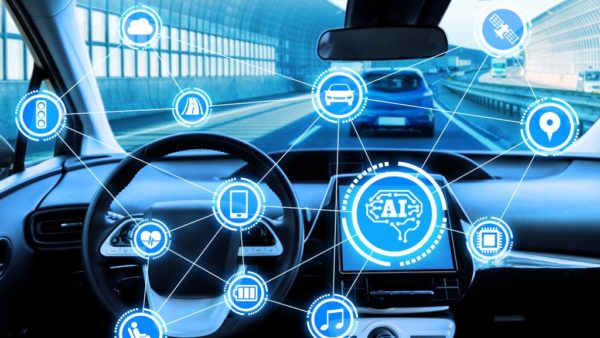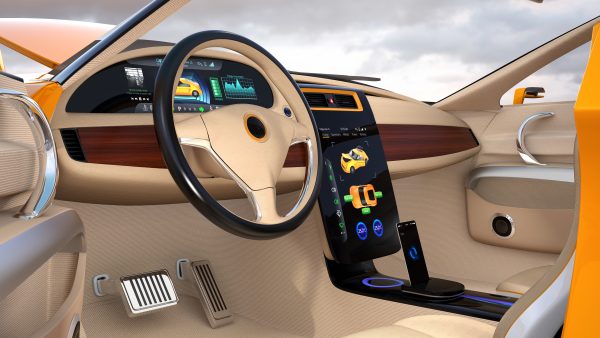Future vehicles will offer greater levels of connectivity and communications, driven not only by in-vehicle comfort and convenience but also by safety considerations.
Advanced software and multimodal sensor systems will facilitate:
- V2V collaborative behavior
- Interaction with V2I interaction
- Congestion mitigation via cellular and/or satellite
The continued growth of sensor technology adoption and proliferation of advanced driver-assist safety technologies, coupled with anticipated 5G mobile networks and a growing demand for high-tech displays (e.g., touchscreens, augmented reality features), will enable the addition of more electronic content to vehicles while increasing the value of vehicle software systems. The growing addition of electronics, sensors, and data processing to future vehicles creates opportunities for advanced plastics and polymer composites in the following areas:
Artificial Intelligence

Design Impacts
Artificial intelligence (AI)-driven techniques will help to optimize travel routes based on traffic conditions, guide electric vehicles to recharging stations, and classify driver health and attentiveness.
Opportunities for Advanced Plastics and Polymer Composites
Advanced plastics and polymer composites can protect expensive electronics and computing hardware from harmful physical vibrations and dangerously high temperatures.
Collaborative Activities
Heat and Shock Protection
| Near (2020–2022)Mid (2023–2025)Long (2026–2030) | |
|---|---|
| * Define material performance requirements required to safeguard electrical and electronic system components | Near, Mid |
| Build public perception of advanced plastics and polymer composites as a key enabler for reducing NVH (i.e., squeaks, rattles, roughness of ride quality) | Near |
| Demonstrate non-conductive, vibration-damping adhesives for joining automotive electronic applications | Near, Mid |
| Increase participation across advocacy groups and key standards committees to permit the integration of nanosensor-embedded advanced plastics and polymer composites | Near, Mid |
| Develop highly durable plastic insulators for safeguarding automotive electronics | Mid |
| Establish integrated test methods (e.g., heat management, shielding, flammability) to aid in the development and certification of automotive electronic components | Mid, Long |
Cybersecurity
Design Impacts

Future connected vehicles may rely on a 5G mobile internet infrastructure for over-the-air updates of onboard software systems. However, the proliferation of sensor-based safety systems raises cyberattack vulnerability concerns for both vehicles and smart infrastructure technologies.
Opportunities for Advanced Plastics and Polymer Composites
Shared vehicles, in particular, will require tamper-resistant polymer exclosures to help reduce physical damage to expensive vehicle electronics without impeding radio signals.
Collaborative Activities
Tamper-Resistant Components
| Near (2020–2022)Mid (2023–2025)Long (2026–2030) | |
|---|---|
| Compile and document best practices for the repair of plastic and polymer composite automotive components for sensors/vehicle to everything (V2X) devices | Mid |
| Demonstrate easy-to-access (i.e., for repair, maintenance, disassembly) polymeric automotive components that are designed to prevent theft, vandalism, and damage to sensors/V2X devices | Mid |
Infotainment
Design Impacts

Higher levels of vehicle autonomy and connectivity are encouraging the integration of electronic displays for more a personalized in-transit driving experience. Information and entertainment systems integrated on the vehicle’s outer surface could function as public displays or potentially change surface color.
Opportunities for Advanced Plastics and Polymer Composites
Protective plastic screens, coatings, and projection surfaces can provide scratch-, chemical-, and shatter-resistance for electronic displays on both the vehicle’s interior and exterior surfaces.
Collaborative Activities
Electronic Displays
| Near (2020–2022)Mid (2023–2025)Long (2026–2030) | |
|---|---|
| Increase collaboration among OEMs, suppliers, and universities to establish standards for scratch-, chemical-, UV-, and shatter-resistant electronic display materials for automotive interiors and exteriors | Near |
| Demonstrate benefits of commercial scratch- and abrasion-resistant coatings for glass and plastic surfaces | Near |
| Establish gloss, reflectivity, transparency, and optical purity standards for safety and entertainment displays | Mid |
| Increase collaborative efforts in legislative, regulatory, and voluntary consensus standard development to enable outer surface display technologies for automotive applications | Mid, Long |
Software and Data Management
Design Impacts

Sensor-based safety systems will generate enormous volumes of data from detecting and classifying the vehicle’s surroundings. Advanced data storage and processing solutions are required to support safe and successful operation of self-driving vehicles.
Opportunities for Advanced Plastics and Polymer Composites
Solid-state plastic RAM devices have low power requirements and elevated thermal resistance necessary for maintaining higher data generation rates of ADAS.
Collaborative Activities
Data-Processing Devices
| Near (2020–2022)Mid (2023–2025)Long (2026–2030) | |
|---|---|
| Define application specifications and requirements for electronic materials and components of ADAS | Near |
| Conduct a demonstration project for solid-state RAM devices to enable high data generation rates ADAS | Mid |
Transportation Grid
Design Impacts

Sensors for autonomous vehicles and transportation infrastructure components must be free from electromagnetic interference (EMI) to facilitate consistent and reliable transmission of real-time information including traffic and congestion data.
Extreme weather conditions could affect the real-time performance of automotive sensors while causing accelerated degradation and aging of automotive materials.
Opportunities for Advanced Plastics and Polymer Composites
Advanced polymeric materials permit both light and imaging transparency and can hide multimodal sensor systems behind body panels, bumpers, and grilles.25
Plastic and polymer composite materials with tailorable shielding properties can help reduce electromagnetic interference for V2X technologies.
Plastics that resist weather, road salt, and UV exposure can prolong vehicle life and protect driver visibility and safety.
Collaborative Activities
EMI Protection
| Near (2020–2022)Mid (2023–2025)Long (2026–2030) | |
|---|---|
| Demonstrate effectiveness, tailorability, and durability of advanced plastics-based radio-opaque materials for conduits, cable jacketing, and other EMI shielding components | Near |
| Characterize the shielding attenuation behavior of polymeric EMI shielding components to create and validate predictive models | Near, Mid |
| Foster development of multifunctional materials for housing and protecting sensors from physical damage and signal interference | Near, Mid |
| Develop models that can simulate EMI behavior of advanced plastics and polymer composites in "fully assembled" vehicle designs | Mid |
| Coordinate with automakers and autonomous component developers to establish materials-agnostic test methods and industry standards for EMI and electromagnetic shielding (e.g., wavelengths, acceptable interference) | Mid, Long |
Weather/UV-Resistance
| Near (2020–2022)Mid (2023–2025)Long (2026–2030) | |
|---|---|
| Develop accelerated aging tests for long-term weathering of automotive plastics and polymer composites to road chemical treatments and UV exposure | Near, Mid |

